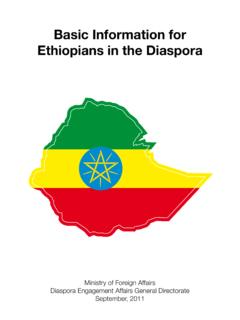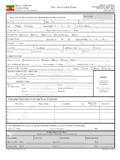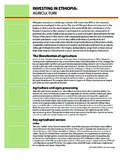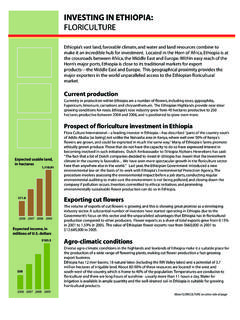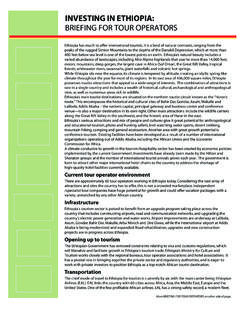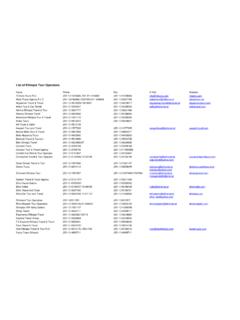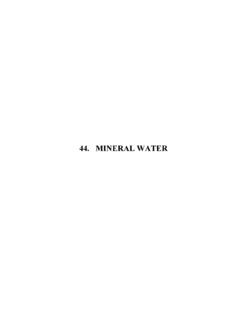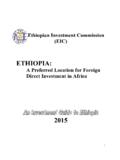Transcription of Investment Office ANRS - Embassy of Ethiopia
1 Investment Office ANRS PROJECT PROFILE ON THE ESTABLISHMENT PROJECT PROFILE ON THE ESTABLISHMENT PROJECT PROFILE ON THE ESTABLISHMENT PROJECT PROFILE ON THE ESTABLISHMENT OF MEAT PROCESSOF MEAT PROCESSOF MEAT PROCESSOF MEAT PROCESSING PLANTING PLANTING PLANTING PLANT DDDD evelopment Studies Associates (DSA)evelopment Studies Associates (DSA)evelopment Studies Associates (DSA)evelopment Studies Associates (DSA) October 2008 Addis Ababa Table of Contents 1. Executive 1 2. Product Description and 1 3. Market Study, Plant Capacity and Production 2 Market Present Demand and Projected Pricing and Plant Production 4. Raw Materials and 5 Availability and Source of Raw Annual Requirement and Cost of Raw Materials and 5 Location and 6 6 Technology and 7 Production Machinery and Civil Engineering 7 Human Resource and Training Requirement.
2 9 Human Training 8 Financial 10 Underlying Production Financial 9 Economic and Social Benefit and 13 ANNEXES .. 15 1 1. Executive Summary This project profile deals with the establishment of meat processing plant in Amhara National Regional State. The following presents the main findings of the study Demand projection divulges that the domestic demand for canned processed meat is substantial and is increasing with time. Accordingly, the planned plant is set to produce 300 tons annually. The total Investment cost of the project including working capital is estimated at Birr million and creates 36 jobs and Birr thousand of income. The financial result indicates that the project will generate profit beginning from the first year of operation. Moreover, the project will break even at of capacity utilization and it will payback fully the initial Investment less working capital in 2 years and 9 months.
3 The result further shows that the calculated IRR of the project is and NPV discounted at 18% of Birr 6,304, In addition to this, the proposed project possesses wide range of economic and social benefits such as increasing the level of Investment , tax revenue, employment creation and rural income. Generally, the project is technically feasible, financially and commercially viable as well as socially and economically acceptable. Hence the project is worth implementing. 2. Product Description and Application Animal products, specifically the red meats of cattle are essential to the human diet. Meat is significantly high in zinc, iron, protein, and vitamins of the B group, particularly B12, and also has a full complement of the essential amino acids. Coming from animals, these micronutrients can also be easily absorbed by the human body. Although there are different meats processing types, this project profile deals with the establishment of canned foods from meat dedicated to urban consumers.
4 Within this activity, raw materials (meat and other ingredients) are complemented by value added product obtained from the processing. For the consumer, the interest lies both in preparation and storage easiness 2 as well as hygienic security. The middle and upper income urban dwellers remain the most favorable market since it combines both the need of saving time and the purchasing power to get this kind of product. 3. Market Study, Plant Capacity and Production Program Market Study Present Demand and Supply With the largest livestock population in Africa, Ethiopia has an ample supply base for the export of live animals and meat. Livestock husbandry is mostly carried out under natural grazing, making the meat and meat products obtained from the animals very tasty and nutritionally healthy for human consumption. Currently there are 5 meat processing plants of which 2 (in Gonder and Combolcha) are located in ANRS, and the rest 3 are located in SNNPR, Dire Dawa and Addis Ababa.
5 These plants supply their product for domestic market as well as for export. Reports in this connection inform that the major consumers of processed meat in our country are members of the armed forces. The report further reveal that these supplying factories are very old. On the other hand, Ethiopia exports live animal and semi processed meat to abroad. The main items exported include live animals and meat products, steers and yearlings; lowland sheep and goats; fresh and chilled lamb and mutton carcass; fresh and chilled goat carcass; fresh and chilled veal carcass and beef four quarter; fresh and chilled boneless veal and beef; frozen lamb, mutton and goat carcass and veal and beef special cuts. The major meat trade partner countries with Ethiopia include Saudi Arabia, Dubai, Egypt, Yemen, Congo Brazzaville, Cote d'Ivoire and South Africa while major destinations for live animals from Ethiopia are Saudi Arabia, Dubai, Yemen and Egypt.
6 Canned (processed) meat is also imported from abroad and it is available in supermarkets. However, the import data obtained from Customs Authority aggregates the canned meat with other related products such as tuna and the like so that exact data on import could not be documented. Table 1, therefore, shows only the annual domestic production of meat by the meat processing plants 3 Table 1: Domestic Production of Meat (in ton) Source: Customs authority, (various yeas) The above table shows that production of processed meat has shown a declining trend in recent years under consideration. The highest level of production has been registered in 2001/02 which then continuously decreased up to 2004/05 which then marginally rises in the following period. The reduction in production partly is low capacity of operation as many of the plants are old and use obsolete machineries.
7 However, the consumption of meat in general is showing a substantial increase in the country as a whole. For instance, research study by Abbey Avery sponsored by International Livestock Research Institute (entitled Red Meat and Poultry Production and Consumption in Ethiopia and Distribution in Addis Ababa - 2004) confirmed that about million cattle had been slaughtered in 1993. This number has increased to about million cattle in the year 2003. Roughly speaking this is about 350 thousand tons of meat and represents the presence of huge demand in the country. The country has immense livestock resource. According to CSA, Annual Abstract (2006), the number of cattle in 2003/04 was million and increased to million in 2005/06. From this the share of Amhara National Regional State has been about 25%. Such huge number suggests the presence of sustainable supply for firms engaged in meat processing.
8 If we compare the number of cattle slaughtered in 2003 (which is million) with the cattle number registered in 2003/04 (which is million) we learn that the consumption level has been If we Year Domestic Production 1997/98 96 1998/99 615 1999/00 526 2000/01 555 2001/02 1194 2002/03 849 2003/04 224 2004/05 208 2005/06 212 4 apply the same ratio to the 2005/06 cattle size, the consumption level of cattle will be million or roughly thousand ton of cattle meat. This can be taken as the present demand for cattle meat in the country where the share of Amhara is estimated to be thousand tons. Projected Demand As presented earlier the annual demand for meat is substantial. Thus, with proper marketing, quality as well as demand based production; it is possible to attract a portion of the consumers to the consumption of processed meat. If we conservatively assume that only of annual consumption will be attracted by modern meat processing plant, the present annual demand for such product would be about 9,255 ton processed meat.
9 Based on this figure we can forecast the future demand for the product. That is if we further assume that demand grows by 3% (parallel with the population growth), the future demand for the processed meat will be as indicated in table 2 below. Table 2: Projected Demand for Processed Meat (in ton) As shown in the above table there is huge untapped potential demand for the product. This demand reaches 10 thousand ton in 2009/10 and increases by about 30% within 10 years (2018/19). Such figure suggests the relevance of establishing meat processing plant. Year Projected Demand 2007/08 9,533 2008/09 9,819 2009/10 10,113 2010/11 10,417 2011/12 10,729 2012/13 11,051 2013/14 11,383 2014/15 11,724 2015/16 12,076 2016/17 12,438 2017/18 12,811 2018/19 13,196 5 Pricing and Distribution Based on the market research result and the capacity of the envisaged plant, the wholesale price of a 500 gram canned processed meat is set to be Birr 17 per piece while Birr is set for a 250 gm product.
10 Moreover, the firm will sell the by-products (bones, etc) and skin at Birr 150 per slaughtered cattle. In distributing the product the envisaged plant shall make use of the available retail and wholesale network. Plant Capacity In light of the expected demand for the product as presented in the previous section, and the planned technology, the envisaged plant is set to produce 300 tons of processed canned food annually. Of this total production, 200 tons of processed meat shall be packed in a 250 gram capacity container while the remaining 100 tons shall be packed in a 500 gram container. Production Program The program is scheduled based on the consideration that the envisaged plant will work 300 days in a year in 1 shift, where the remaining days will be holidays and for maintenance. During the first year of operation the plant will operate at 35 percent capacity and then it grows to 55 percent in the 2nd year 75 percent in the 3rd year and 95 percent in the 4th year.
